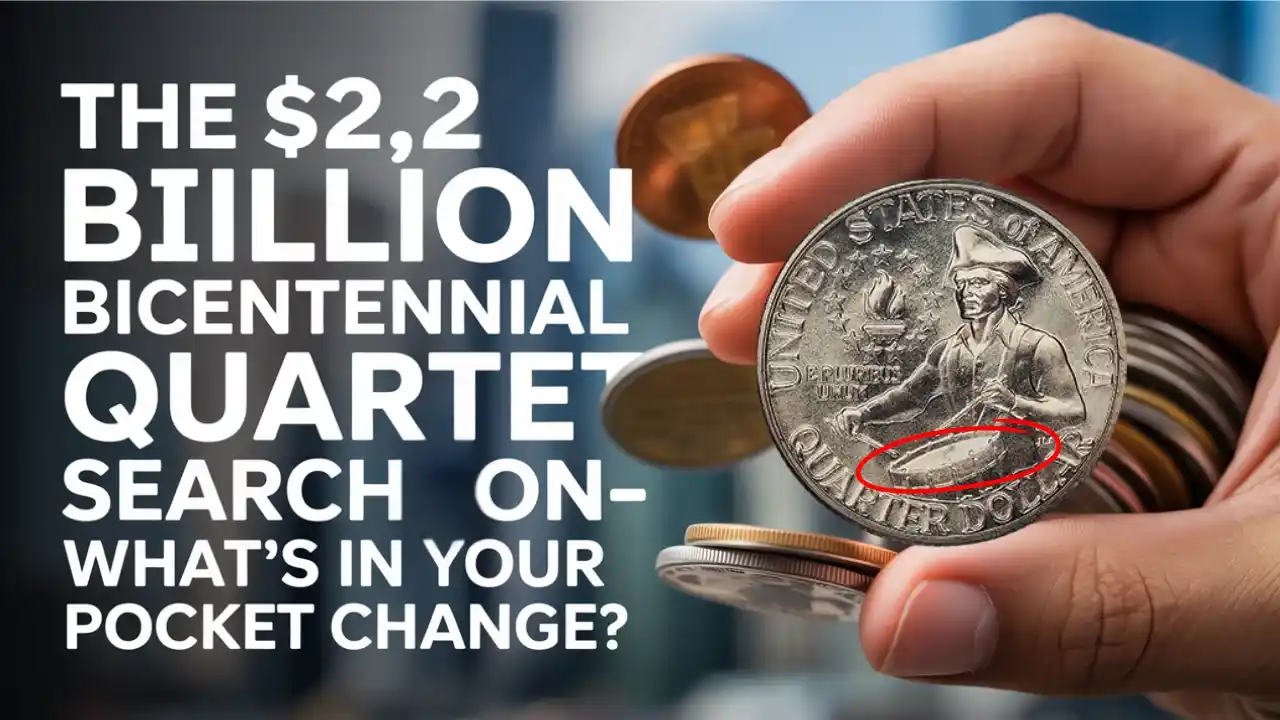Bicentennial Quarter Hunt: Could the 1776-1976 Coin in Your Pocket Be Worth a Fortune? Bicentennial Quarter Craze Sweeps America Across the United States, coin collectors and curious citizens are buzzing about the possibility that a Bicentennial Quarter could be worth an eye-popping sum. While claims of a $2.2 billion value are largely exaggerated, the excitement is very real — and it’s driving people to check their pocket change like never before. Could an overlooked coin in your wallet be a hidden treasure?
The search for the $2.2 billion Bicentennial quarter continues: Coin collectors and ordinary Americans are in for a fresh wave of excitement as rumors spread about a Bicentennial quarter that is potentially worth $2.2 billion. Yes, you read that right — billions, not millions. Although experts advise to be wary of exaggerated claims, the buzz is real, and the search is on. Could a small coin in your pocket be one of the most valuable coins ever discovered?
Why the Bicentennial Quarter Is Unique
The U.S. Mint issued the Bicentennial Quarter in 1975 and 1976 to celebrate 200 years of American independence. Unlike ordinary quarters, these coins feature:
-
Special Reverse Design: A Colonial-era drummer with a torch surrounded by 13 stars, representing the original states.
-
Dual Date: “1776-1976” beneath George Washington’s profile on the front.
-
Limited Production Period: Minted only for the Bicentennial celebration.
While most of these coins remain common and worth just 25 cents, certain rare variations, minting errors, and high-grade specimens have caught the attention of collectors — sometimes selling for tens of thousands of dollars.
Why are Bicentennial quarters so special?
The Bicentennial quarters were minted in 1975 and 1976 to commemorate the 200th anniversary of American independence. Unlike the regular quarters, the reverse has a unique design, with a colonial drummer and a torch surrounded by 13 stars – representing the original colonies. The obverse still features George Washington, but with the double date “1776-1976” inscribed below.
Although most Bicentennial quarters are common and worth face value, some rare varieties – particularly those with mint errors or made of precious metals – have attracted the attention of collectors and auction houses.
Recommended by
Separating Fact from Fiction
The viral $2.2 billion figure is not linked to any verified auction or documented sale. However, the growing interest in rare U.S. coins is undeniable. Experts note that exceptional examples of Bicentennial Quarters — such as proof coins, silver composition strikes, and unique mint errors — can fetch significant sums.
-
Proof coins from San Francisco in 40% silver can be especially valuable.
-
Error coins such as double dies, off-center strikes, or missing details are highly sought-after.
-
High-grade, uncirculated coins graded by PCGS or NGC can command premium prices.
How to Identify a Potentially Valuable Bicentennial Quarter
If you’ve got a 1776-1976 quarter, here’s what to check:
-
Date & Mint Mark – Look for “1776-1976” and check for a mint mark:
-
D = Denver
-
S = San Francisco (proofs and silver strikes)
-
No mint mark = Philadelphia
-
-
Metal Composition – Some “S” mint mark coins are 40% silver.
-
Minting Errors – Doubling in lettering, off-center images, or unusual rim shapes can indicate rarity.
-
Condition – The closer to mint state, the higher the value potential.
If you suspect your quarter is rare, consider sending it to a professional grading service for authentication and appraisal.
Why the Hype Matters
This story isn’t just about coins — it’s about the thrill of finding something extraordinary in everyday life. The Bicentennial Quarter has sparked renewed interest in numismatics, especially among younger generations, who are now actively checking their loose change and posting their finds on social media.
The hunt is inspiring curiosity, conversation, and maybe even the discovery of hidden wealth.
Final Word
While a $2.2 billion Bicentennial Quarter is almost certainly a myth, rare coins can still be worth impressive amounts. If you have a 1776-1976 quarter, it’s worth taking a closer look. Who knows? Your spare change might hold a piece of history — and maybe a nice payday.
FAQs on Bicentennial Quarters
Q1. What is a Bicentennial Quarter?
A special U.S. quarter issued in 1975–1976 to mark America’s 200th anniversary, featuring a drummer design on the reverse and the dual date 1776-1976.
Q2. Can Bicentennial Quarters be worth money?
Yes. While most are worth face value, rare silver proofs, mint errors, or high-grade examples can be worth hundreds or even thousands of dollars.
Q3. How do I know if my quarter is silver?
Check for an “S” mint mark and weigh the coin — 40% silver quarters are heavier than standard clad coins.
Q4. Where should I sell a rare quarter?
Through reputable coin dealers, auction houses, or online marketplaces specializing in numismatics.
Q5. Has a Bicentennial Quarter ever sold for $2.2 billion?
No. This figure is an internet rumor. The most valuable Bicentennial Quarters have sold for tens of thousands of dollars.
